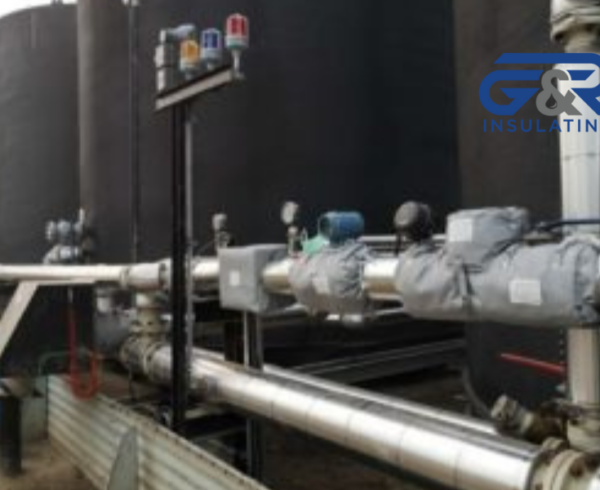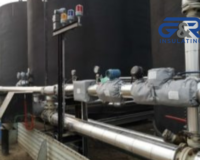There’s no denying the importance of properly insulating piping systems to ensure optimal performance and energy efficiency. Piping insulation is critical in reducing heat loss and preventing condensation, whether it’s for hot water, chilled water, or steam systems. To help you navigate the ins and outs of piping insulation, check out this GUIDE TO INSULATING CHILLED WATER PIPING for valuable tips and recommendations.
Understanding The Importance Of Insulation
The proper insulation of piping systems is crucial for various reasons. It helps maintain the temperature of the fluid being transported inside the pipes, preventing heat loss or gain. Insulation also protects pipes from freezing in cold environments and reduces the risk of condensation forming on the exterior of the pipes.
Factors Affecting Heat Loss in Piping Systems
The amount of heat lost in a piping system can be influenced by several factors. Including the temperature difference between the fluid inside the pipe and the surrounding environment, the length and diameter of the pipe, and the type of insulation used.
- Temperature difference
- Pipe dimensions
- Insulation material
Assume that these factors play a significant role in determining the effectiveness of insulation in a piping system.
Benefits of Proper Insulation
Proper insulation of piping systems offers various benefits, such as energy savings by reducing heat loss, maintaining consistent fluid temperatures, minimizing the risk of pipe corrosion, and extending the lifespan of the piping system.
The insulation also helps improve overall system efficiency and reduce operating costs in the long run, making it a worthwhile investment for any piping system.
Types Of Insulation For Piping Systems
Any well-insulated piping system requires the use of appropriate insulation materials. Knowing the different types available can help you make an informed decision. Importantly, here is a breakdown of various insulation options in the table below:
| Fiberglass Insulation | Foam Insulation |
| Reflective Insulation | Mineral Wool Insulation |
| Cellular Glass Insulation |
Fiberglass Insulation
Even though commonly used, fiberglass insulation can be irritating to the skin and lungs during installation.
Foam Insulation
Insulation made from foam materials like polyurethane or polystyrene can provide excellent thermal resistance and moisture control. For instance, closed-cell foam insulation is ideal for outdoor piping systems that are exposed to harsh weather conditions.
Reflective Insulation
Piping systems can benefit from reflective insulation, which helps to control heat gain or loss in addition to providing moisture resistance. This type of insulation typically consists of a foil or film layer that reflects heat away from the pipe.
Mineral Wool Insulation
There’s mineral wool insulation made from fibers of natural or synthetic minerals that offer high-temperature resistance and fire protection properties. Reflective aluminum foil facing can also be added to mineral wool insulation for enhanced thermal performance.
Cellular Glass Insulation
Any piping system that requires insulation in extreme temperatures may benefit from cellular glass insulation, as it offers excellent thermal stability. Another advantage of cellular glass insulation is its resistance to water absorption, making it suitable for underground piping applications.
Explore the various insulation options to find the best fit for your piping system’s needs.
Tips For Selecting The Right Insulation
After deciding to insulate your piping system, the next crucial step is selecting the right insulation. Here are some tips to help you make the best choice:
- Considering Climate and Environmental Factors
- Evaluating Insulation Material Properties
- Assessing Budget and Cost-Effectiveness
Considering Climate and Environmental Factors
In your quest to find the right insulation for your piping system, considering climate and environmental factors is crucial. Factors such as temperature fluctuations, humidity levels, and exposure to elements can all impact the effectiveness and durability of the insulation. Assume that the chosen insulation can withstand the specific environmental conditions to ensure long-term performance.
Assessing Budget and Cost-Effectiveness
If budget constraints are a concern, it’s important to assess the cost-effectiveness of different insulation options. Factors such as initial costs, installation expenses, and long-term energy savings should all be taken into account when selecting insulation for your piping system. Insulation that offers a good balance between upfront costs and long-term energy efficiency can provide the best value for your investment.
Step-by-Step Guide to Insulating Piping Systems
Preparing the Piping System for Insulation
Now that you have gathered all the necessary materials, the first step is to ensure that the piping system is clean and free of any debris. This will help the insulation materials adhere properly to the pipes and provide maximum effectiveness.
Measuring and Cutting Insulation Materials
Some of the key factors to consider when measuring and cutting insulation materials include the diameter of the pipes, the thickness of insulation needed, and any additional fittings or bends in the piping system. Accurate measurements are crucial to ensure a proper fit and effective insulation.
Insulation: It is important to measure and cut the insulation materials with precision to avoid any gaps or overlaps that can compromise the effectiveness of the insulation.
Installing Insulation Materials
With the insulation materials cut to size, carefully wrap them around the pipes, ensuring a snug fit without stretching or compressing the material. Secure the insulation using adhesive or tape, especially at joints and seams, to prevent heat loss or gain.
Measuring: Before securing the insulation, double-check the measurements to ensure a proper fit and coverage of the piping system for maximum efficiency.
Securing Insulation in Place
The final step in insulating piping systems is to secure the insulation using more permanent methods such as strapping or cladding. This will help maintain the integrity of the insulation over time and prevent any slippage or displacement that could reduce its effectiveness.
Plus, ensuring the insulation is properly secured will also enhance the overall aesthetic appearance of the piping system, giving it a clean and professional finish.
Factors to Consider When Insulating Piping Systems
Despite the simplicity of insulating piping systems, several crucial factors need to be considered to ensure effective insulation.
Pipe Size and Material
Factors such as the size and material of the pipe play a crucial role in determining the type of insulation required for optimal performance.
Insulation Thickness and Coverage
Insulating piping systems with the right thickness and coverage is crucial to prevent heat loss, and conserve energy. Maintain the desired temperature of the fluid inside the pipe.
For instance, thicker insulation is needed for pipes that carry hot fluids, while proper coverage is crucial to ensure no areas are left exposed.
Joint and Fitting Insulation
Proper joint and fitting insulation is crucial to prevent heat loss and energy inefficiency
Covering joints and fittings with insulation helps maintain a consistent temperature throughout the system and prevents energy wastage.
Insulation for Exposed Piping
Insulating exposed piping is crucial to protect it from external elements and prevent heat loss, ultimately saving energy and reducing operational costs.
Insulation for exposed piping also helps in preventing condensation buildup and potential corrosion issues, extending the lifespan of the piping system.
Pros and Cons of Different Insulation Materials
Fiberglass Insulation: Advantages and Disadvantages One of the most common types of insulation materials is fiberglass. It is cost-effective, easy to install, and has good thermal performance. However, fiberglass can cause skin irritation and respiratory issues if not handled properly.
Foam Insulation: Advantages and Disadvantages Different from fiberglass, foam insulation offers a higher R-value per inch, providing better thermal resistance. It can also act as a moisture barrier. On the downside, foam insulation is more expensive and can be challenging to repair if damaged.
Reflective Insulation: Advantages and Disadvantages Assuming proper installation, reflective insulation can effectively reduce radiant heat transfer. It is lightweight and easy to install. However, its effectiveness highly depends on the environment it is placed in.
Mineral Wool Insulation: Advantages and Disadvantages Consisting of natural materials like rock or slag wool, mineral wool insulation is fire-resistant and has good sound-absorbing properties. On the other hand, it can be more costly than other insulation materials and may require special handling during installation.
Cellular Glass Insulation: Advantages and Disadvantages Advantages of cellular glass insulation include being water-resistant, fire-resistant, and not promoting mold growth. However, it is relatively expensive and can be fragile, requiring careful handling to prevent breakage.
Conclusion
Proper insulation of pipelines is important to maintain fluid temperature, prevent heat loss and improve energy efficiency. Pipe insulation types such as fiberglass, foam, reflective, mineral wool and foam glass offer unique advantages and disadvantages. Effective insulation reduces energy costs, extends the life of piping systems and prevents problems such as freezing and condensation. Choosing the right pipe insulation must take into account environmental factors, material properties and budget constraints. Accurate measurement, precise cutting and safe installation are important steps to ensure optimal performance. Ultimately, well-selected and properly installed pipe insulation improves system efficiency and provides long-term savings, making it a valuable investment in any pipe system.



















